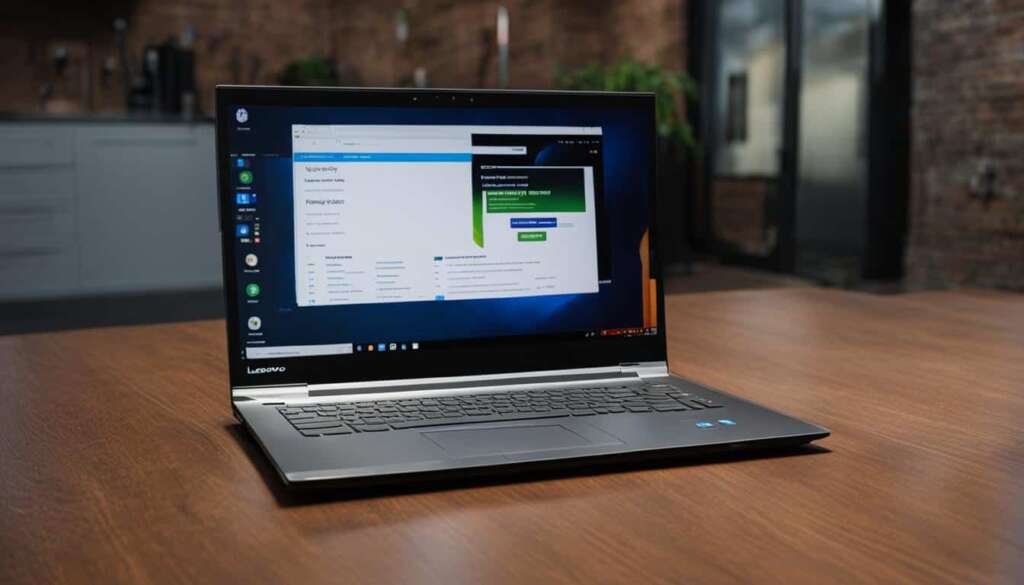Table of Contents
Are you ready to embark on a new chapter with your computer? Discover the secrets to wiping your computer clean and starting fresh. Whether you’re looking to sell or give away your device, or simply want to optimize its performance, wiping your computer is the key to unlocking a world of possibilities.
By following a few simple steps, you can securely erase your computer’s data and restore it to its factory conditions. Say goodbye to unwanted files, outdated programs, and sluggish performance. It’s time to reclaim your hard drive space and experience the power of a clean slate.
Key Takeaways
- Discover how to wipe your computer and start fresh
- Safely remove personal data and protect your privacy
- Improve performance and free up storage space
- Learn the steps to encrypt your SSD before wiping
- Find out how to wipe a Windows or Mac computer
Why should you wipe your computer?
Wiping your computer is essential for several reasons. Firstly, it removes personal data and protects your privacy when selling or giving away your computer. It also clears out any unwanted or outdated files, programs, and settings, improving performance and freeing up storage space. Additionally, wiping a computer can help eliminate malware and viruses that may be lurking in the system. It’s a crucial step to ensure a fresh start and maintain the security and efficiency of your device.
By wiping your computer, you can safeguard your personal information from falling into the wrong hands. When you sell or dispose of your computer, simply deleting files or formatting the hard drive is not enough to completely erase sensitive data. Wiping your computer ensures that the deleted files are permanently removed and cannot be recovered by any means. This is especially important if you had stored personal documents, financial records, or any other confidential information on your computer. Wiping your computer provides peace of mind, knowing that your data is no longer accessible to anyone.
Another benefit of wiping your computer is the improvement in performance. Over time, computers accumulate unnecessary files, temporary data, and outdated software that can slow down their speed and performance. By wiping your computer, you remove all these unnecessary files and software, giving your device a fresh start. This can significantly improve its speed, responsiveness, and overall performance. Additionally, wiping your computer frees up valuable storage space, allowing you to store more files, photos, and videos without the fear of running out of space.
In conclusion, wiping your computer is not just a recommended practice, but a necessary one. It protects your privacy, improves performance, and ensures a fresh start for your device. Whether you’re selling, giving away, or simply wanting to optimize your computer, wiping the hard drive is an essential step. So, take the time to wipe your computer and enjoy the benefits of a clean, secure, and efficient device.
How to Encrypt Your SSD Before Wiping
If your computer has a solid-state drive (SSD), it’s important to encrypt it before wiping to ensure data erasure and protect your sensitive information. Encrypting your SSD adds an extra layer of security by converting your data into an unreadable format that can only be accessed with the correct encryption key.
To encrypt your SSD before wiping, follow these simple steps:
- Open the Windows “Settings” menu by clicking on the Start button and selecting the gear icon.
- Navigate to “System” and then “About.”
- Check if your device supports Device Encryption. If it does, follow the instructions to encrypt your hard drive.
- If your PC doesn’t have the Device Encryption option, you may be able to enable BitLocker depending on your Windows 10 version. BitLocker provides advanced encryption capabilities.
- If neither of these options is available, you can install a third-party encryption tool such as TrueCrypt or VeraCrypt. These tools offer robust encryption features to safeguard your data.
By encrypting your SSD before wiping, you ensure that even if someone tries to recover your erased data, it will remain encrypted and inaccessible, protecting your privacy and sensitive information.
| Benefits of SSD Encryption Before Wiping |
|---|
| Protects your sensitive data from unauthorized access |
| Ensures data erasure by converting it into an unreadable format |
| Adds an extra layer of security to your device |
| Prevents potential data breaches and identity theft |
Encrypting your SSD before wiping is a crucial step in maintaining data privacy and ensuring a secure process. Follow these steps to protect your sensitive information and enjoy peace of mind when wiping your computer.
How to Wipe Your Windows Computer
If you’re looking to wipe your Windows computer and return it to its factory settings, follow these simple steps:
- Open the “Settings” menu by clicking on the Start button and selecting the gear icon.
- In the “Settings” menu, click on “Update & Security.”
- From the left-hand menu, choose “Recovery.”
- In the “Reset this PC” section, click on “Get started.”
- Select the option to “Remove everything.”
- Follow the on-screen instructions to complete the process.
By following these steps, you can easily wipe your Windows computer and restore it to its original configuration. Remember to back up any important data before initiating the wipe to avoid losing any files.
Wiping your Windows computer can help improve performance, remove unwanted files and programs, and ensure that your personal data is securely erased. It’s an essential step to take before selling or giving away your computer to protect your privacy.
“Wiping your computer clean and starting fresh can reclaim hard drive space and restore optimal performance.” – Computer Expert
Keep in mind that the exact steps may vary slightly depending on your Windows version, but the general process remains the same.
| Step | Description |
|---|---|
| 1 | Open the “Settings” menu by clicking on the Start button and selecting the gear icon. |
| 2 | In the “Settings” menu, click on “Update & Security.” |
| 3 | From the left-hand menu, choose “Recovery.” |
| 4 | In the “Reset this PC” section, click on “Get started.” |
| 5 | Select the option to “Remove everything.” |
| 6 | Follow the on-screen instructions to complete the process. |
Following these steps and using the built-in reset feature of Windows, you can confidently wipe your computer and start fresh with a clean slate.

How to Wipe Your Mac Computer
Wiping a Mac computer is a necessary step to ensure your data is securely erased and your device is returned to its factory settings. Follow these steps to wipe your Mac:
Step 1: Back up your data
Before wiping your Mac, it’s important to back up your data to prevent any loss of important files or documents. Use Apple’s Time Machine utility or an external storage device to create a backup of your files.
Step 2: Access Disk Utility
Turn off your Mac and then hold down the Command + R keys while turning it back on. This will boot your Mac into the recovery mode. From the options presented, select “Disk Utility.”
Step 3: Select the drive to erase
In Disk Utility, choose the drive you want to erase from the list of available drives on the left side of the window. Be sure to select the correct drive as this process will permanently delete all data on the selected drive.
Step 4: Erase the drive
Click on the “Erase” button in Disk Utility. A dialog box will appear, allowing you to choose the file system and name the drive. Select the desired file system and provide a name for the drive. Finally, click on “Erase” to wipe your Mac and restore it to its factory settings.
Remember, wiping your Mac will permanently delete all data on the selected drive, so be sure to back up any important files before proceeding with the wipe. This process will also remove any installed software and applications, so make sure to reinstall any necessary programs after the wipe is complete.
| Advantages of Wiping Your Mac | Disadvantages of Wiping Your Mac |
|---|---|
| Ensures complete data erasure | Permanent deletion of all files |
| Restores your Mac to its factory settings | Loss of installed software and applications |
| Improves performance and efficiency | Requires reinstallation of necessary programs |
| Protects your personal data and privacy | Loss of any unsaved work or documents |
“Wiping your Mac is a crucial step to safeguard your personal information and prevent unauthorized access to your data. By following the correct steps and backing up your files beforehand, you can ensure a fresh start and optimal performance for your Mac.”
Why Should You Completely Wipe a Hard Drive?
Completely wiping a hard drive is of utmost importance for several reasons. Firstly, it ensures that your personal data is irretrievable when selling, trading in, or discarding your computer. By wiping the hard drive, you prevent potential data theft, identity theft, and other malicious activities that could be carried out using the information stored on the drive. Secondly, wiping a hard drive is crucial when getting rid of damaged drives or upgrading to a solid-state drive (SSD). Starting fresh with a wiped hard drive allows you to restore maximum operating efficiency to your device.
Additionally, wiping a hard drive helps maintain data privacy and security. It eliminates the risk of unauthorized access to sensitive information and ensures that your personal and confidential files are completely removed from the system. It is especially important to wipe a hard drive before selling or giving away a computer to protect your privacy and prevent any potential misuse of your data.
Furthermore, wiping a hard drive allows you to start with a clean slate, removing any traces of unwanted or outdated files, programs, and settings. It helps improve overall performance by freeing up storage space and optimizing system resources. By wiping a hard drive, you can create a fresh environment for your computer, enhancing its speed, responsiveness, and overall user experience.

| Benefits of Wiping a Hard Drive | Reasons to Wipe a Hard Drive |
|---|---|
|
|
How to Wipe a Hard Drive in Windows
When it comes to wiping a hard drive in Windows, there are a few options available to ensure complete data erasure. One method is to use the built-in reset feature, which is a convenient way to erase the hard drive and reinstall Windows. To do this, go to the “Settings” menu, select “Update & Security,” and choose “Recovery.” Click on “Reset this PC” and follow the on-screen instructions to initiate the process. It’s important to note that this method may not be as thorough as using specialized data sanitization software.
If you require a more comprehensive approach to wiping your hard drive, you can consider using third-party software tools. These tools offer advanced data sanitization methods that can securely and permanently erase all data from your hard drive. Popular options include DBAN, CCleaner, and CBL Data Shredder. Before using any third-party software, make sure to choose a reputable tool and follow the instructions carefully to ensure effective and thorough data wiping.
The Importance of Factory Reset
“A factory reset is not only essential for data privacy but also for maintaining the performance and longevity of your computer. By wiping the hard drive, you can remove unwanted files, programs, and settings that may be slowing down your system. It also provides a fresh start, allowing you to reclaim storage space and optimize your computer’s performance.”
Before initiating the wipe process, it is crucial to back up any important data you want to keep. Once the hard drive is wiped, all data will be permanently erased, and recovery will no longer be possible. After successfully wiping the hard drive, you can reinstall Windows or use the computer for a fresh setup. Remember to take the necessary precautions and choose the method that best suits your needs to ensure a secure and hassle-free experience.
How to Wipe a Hard Drive in macOS
Wiping a hard drive in macOS requires a few simple steps to ensure your data is securely erased. Follow these instructions to reset your Mac to factory settings and protect your privacy.
Step 1: Back up your data
Before wiping your hard drive, it’s crucial to back up your data to prevent any loss. Use Time Machine or other backup methods to create a copy of your important files and documents. This ensures that you can easily restore your data once the wiping process is complete.
Step 2: Access Disk Utility
To begin the wiping process, restart your Mac and hold the Command + R keys until the Apple logo appears. This will boot your Mac into Recovery Mode. From the utilities menu, select “Disk Utility.”
Step 3: Erase the hard drive
In the Disk Utility window, select the hard drive you want to erase from the sidebar. Be cautious to choose the correct drive as the selected drive will be permanently erased. Click on the “Erase” button and choose a file system format for your hard drive.

It’s recommended to use the “Mac OS Extended (Journaled)” option. Enter a name for your erased hard drive, and click on the “Erase” button once more to confirm. The Disk Utility tool will now wipe your hard drive and return it to its factory settings.
Note: The wiping process may take some time depending on the size of the hard drive. Ensure that your Mac is connected to a power source to avoid any interruptions during the erasure.
Once the wiping process is complete, your hard drive will be clean and ready for a fresh start. You can now reinstall macOS or transfer your backed-up data to your Mac. Remember to securely dispose of or recycle your old hard drive if you no longer need it.
Data Sanitization Tools for Secure Hard Drive Wiping
When it comes to securely wiping a hard drive, using reliable and effective data sanitization software is essential. These third-party tools offer advanced features and techniques to ensure that all data is permanently and irreversibly erased from your hard drive. Whether you’re preparing to sell your computer or disposing of an old hard drive, here are some popular data sanitization software options to consider:
DBAN (Darik’s Boot and Nuke)
DBAN is a widely recognized and trusted tool for wiping hard drives. It operates by completely overwriting the entire hard drive with random data, making data recovery virtually impossible. DBAN is easy to use and offers comprehensive wiping options, including the ability to target specific partitions or drives.
CCleaner
While CCleaner is primarily known as a system optimization and cleaning tool, it also provides data wiping capabilities. Its Drive Wiper feature allows you to securely erase selected drives, ensuring that no traces of sensitive information remain. CCleaner offers multiple data wiping algorithms, including the widely recommended Gutmann method.
CBL Data Shredder
CBL Data Shredder is a robust data erasure tool that meets industry standards for secure data wiping. It uses various algorithms, such as DoD 5220.22-M and NIST 800-88, to ensure complete data eradication. With CBL Data Shredder, you can confidently wipe hard drives, solid-state drives (SSDs), and even individual files or folders.
It’s important to note that when using any data sanitization software, carefully follow the instructions provided by the software developer. Additionally, consider the level of security and data erasure required for your specific needs. While these tools offer powerful capabilities, remember that data recovery is extremely difficult once the wiping process is complete. Always make sure to back up any important data before initiating a wipe.
| Data Sanitization Tool | Features |
|---|---|
| DBAN | Comprehensive wiping options, random data overwriting |
| CCleaner | Drive Wiper feature, multiple wiping algorithms |
| CBL Data Shredder | Meets industry standards, various erasure algorithms |
Conclusion
Wiping a computer is an essential step towards safeguarding your data privacy and ensuring a secure and fresh start. By following the appropriate steps for your operating system, such as wiping a Windows or Mac computer, you can effectively erase personal information and protect against data theft.
Whether you’re selling, giving away, or upgrading your computer, it’s crucial to perform a secure computer wipe to remove all traces of sensitive data. Factory reset options provided by your operating system can help you achieve this goal. Additionally, backing up your data before initiating the wipe ensures that your important files and documents are safely retained.
By prioritizing computer data erasure, you not only protect your own privacy but also contribute to the overall security of your digital environment. Embracing the concept of secure computer wipe empowers you to reclaim the full performance potential of your device, allowing for a smooth and efficient computing experience.
Remember, maintaining data privacy is a shared responsibility. Taking the time to wipe your computer properly ensures that your personal information remains secure and confidential, offering you peace of mind in an increasingly interconnected world.
FAQ
Why is it important to wipe a computer?
Wiping a computer removes personal data, protects privacy, improves performance, frees up storage space, and helps eliminate malware and viruses.
How do I encrypt my SSD before wiping?
Open the Windows “Settings” menu, navigate to “System” and then “About,” check if your device supports Device Encryption, and follow the instructions. If not, you can enable BitLocker or use third-party encryption tools.
How do I wipe my Windows computer?
Open the “Settings” menu, click on “Update & Security,” choose “Recovery,” select “Reset this PC,” and follow the on-screen instructions to remove everything and reset to factory settings.
How do I wipe my Mac computer?
Back up your data, turn off your Mac, hold the Command + R keys while powering it back on, select “Disk Utility,” choose the drive you want to erase, click on “Erase,” and confirm the erasure.
Why is it important to completely wipe a hard drive?
Completely wiping a hard drive ensures personal data is unrecoverable, prevents data theft, identity theft, and malicious activities, and is essential when selling, discarding, or upgrading a computer.
How do I wipe a hard drive in Windows?
Use the built-in reset feature by going to the “Settings” menu, selecting “Update & Security,” and choosing “Recovery.” Follow the on-screen instructions or use specialized data sanitization software.
How do I wipe a hard drive in macOS?
Back up your data, choose “Disk Utility” from the Utilities menu, select the drive you want to erase, click on “Erase,” choose a file system, and confirm the erasure.
Are there third-party software tools for wiping a hard drive?
Yes, popular options include DBAN, CCleaner, and CBL Data Shredder. These tools provide advanced data sanitization methods for secure and complete data erasure.
Why should I wipe my computer?
Wiping a computer protects data privacy, ensures a fresh start, removes personal information, and prevents data theft. It is essential when selling, giving away, or upgrading a computer.













